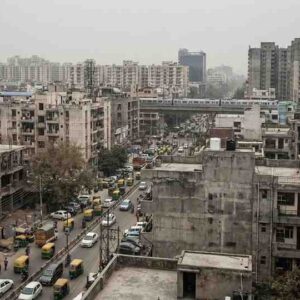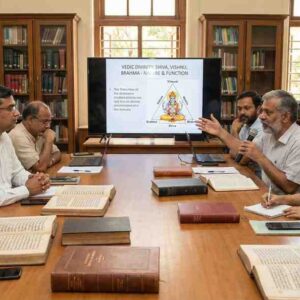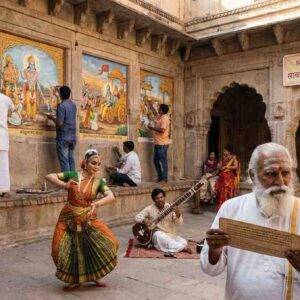Traditional Wisdom Meets Modern Strategies in Tackling the State’s Environmental Challenges
Lucknow– Uttar Pradesh, India’s most populous state, stands at a crossroads in its efforts to address escalating environmental issues. From centuries-old practices rooted in Vedic traditions and Sufi-Bhakti philosophies to cutting-edge technological solutions, the state employs a diverse range of strategies. Yet, the divergence in approaches—between rural traditions and urban policies—raises critical questions about the effectiveness and inclusivity of these efforts.
As pollution, deforestation, and water scarcity continue to threaten the state’s ecological stability, striking a balance between traditional knowledge and modern initiatives is more important than ever.
Key Metrics Highlighting Uttar Pradesh’s Environmental Crisis
- Air Pollution: Kanpur and Lucknow are among the world’s most polluted cities, with PM2.5 levels consistently exceeding 90 µg/m³ (IQAir Report 2023).
- Water Stress: Over 70% of rural households face groundwater depletion, with Bundelkhand among the most affected regions (Central Ground Water Board 2023).
- Deforestation: Uttar Pradesh lost 18,000 hectares of forest cover in the past decade due to urbanization and industrial expansion (Forest Survey of India 2023).
- River Pollution: The Ganga and Yamuna rivers remain heavily polluted, despite ongoing clean-up initiatives under the Namami Gange Mission (Namami Gange Report 2023).
Traditional Approaches to Conservation
1. Vedic Reverence for Nature
Rooted in ancient scriptures, the Vedic philosophy emphasizes harmony with nature through sustainable practices.
- In Practice: Rainwater harvesting and organic farming remain common in rural areas, reflecting these principles.
- Cultural Connection: Rituals such as Chhath Puja, where rivers are worshipped, symbolize the spiritual importance of preserving natural resources.
2. Sufi and Bhakti Philosophies
The teachings of Sufi saints and Bhakti poets like Kabir highlight environmental stewardship as a moral duty.
- Community Efforts: Shrines and temples often maintain green spaces, promoting coexistence with nature.
- Contemporary Applications: In cities like Amroha and Bareilly, interfaith initiatives work on afforestation and river clean-ups inspired by these philosophies.
3. Gandhian Simplicity
Mahatma Gandhi’s emphasis on ecological balance continues to influence grassroots movements in Uttar Pradesh.
- Examples: Women-led self-help groups in Bundelkhand are adopting Gandhian methods to combat water scarcity and promote eco-friendly livelihoods.
Modern Strategies in Environmental Policy
1. Government-Led Programs
State-led initiatives like theNamami Gange Missionaim to rejuvenate rivers through large-scale infrastructure projects, such as sewage treatment plants.
- Progress: Over 140 sewage treatment plants have been constructed to reduce river pollution.
- Challenges: Implementation gaps in rural areas hinder the mission’s broader impact.
2. Urban-Centric Technological Solutions
Cities like Kanpur and Noida are adopting tech-driven strategies to combat environmental issues.
- Key Developments: Air quality monitoring systems and waste-to-energy plants are integral to urban conservation efforts.
- Criticism: These urban-focused projects often overlook rural needs, creating an imbalance in environmental interventions.
3. Corporate Social Responsibility (CSR) Initiatives
Industries are increasingly aligning with global sustainability goals to address environmental challenges.
- Notable Efforts: Agro-industries in western Uttar Pradesh are investing in renewable energy and water-saving technologies.
Contrasting Philosophies in Action
- Community-Led Efforts vs. Centralized Policies: Rural communities prioritize low-cost, sustainable practices like rainwater harvesting, while urban strategies rely on centralized, large-scale interventions.
- Spiritual Connection vs. Practical Goals: Traditional philosophies view conservation as a spiritual obligation, whereas modern policies emphasize measurable outcomes such as emission reductions and biodiversity preservation.
- Inclusivity vs. Top-Down Governance: Local governance models like Panchayati Raj systems ensure grassroots involvement, contrasting with state-led programs that often exclude rural voices.
Challenges to Unified Environmental Conservation
- Disconnect Between Rural and Urban Approaches: Urban-centric policies fail to integrate the traditional wisdom of rural communities.
- Economic Inequality: Limited resources in rural areas prevent the adoption of advanced technologies, widening the gap between urban and rural conservation efforts.
- Lack of Collaboration: Minimal coordination between local governance bodies and state-led initiatives hampers holistic progress.
Government and Community Recommendations
1. Bridging Traditional and Modern Knowledge
- Combine traditional practices, such as organic farming, with modern technologies like drip irrigation to create hybrid solutions.
2. Expanding Community Participation
- Strengthen Panchayati Raj institutions and involve self-help groups in state-level decision-making.
3. Enhancing Educational Outreach
- Introduce environmental education that includes both ancient philosophies and contemporary strategies in schools and colleges.
4. Region-Specific Interventions
- Focus on drought-prone areas like Bundelkhand with targeted water conservation and afforestation programs.
Conclusion
Uttar Pradesh’s environmental conservation efforts showcase a diverse spectrum of philosophies, from age-old traditions to modern strategies. While traditional wisdom emphasizes harmony and inclusivity, modern policies focus on technology and efficiency. Bridging these approaches is crucial to creating a sustainable and inclusive framework for addressing the state’s ecological challenges.
As Uttar Pradesh moves forward, its ability to integrate these contrasting perspectives will determine the success of its environmental initiatives, ensuring a balance between progress and preservation.













